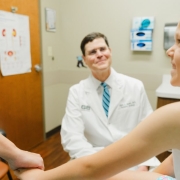What Happens When Your Child Is Detected With an Undescended Testicle?
What Is a Testicle?
Testicles are the male gonads; ovaries are the female form. From birth to puberty, testicles do not have many functions. However, once puberty begins, the testicles produce testosterone, the hormone responsible for male development and the sperm needed for fertility. Men have two testicles in the sack of skin called the scrotum.
What Does It Mean When Testicles Descend?
Testicles start their development in the pelvis when a child is inside the womb. The testes come down to the scrotum through the groin, also called the inguinal canal, by a complicated process that is not very well understood. Believe it or not, the purpose of the scrotum is to keep the testicles at a slightly cooler temperature necessary for them to grow and function properly.
What if They Don’t Descend?
About 70% of testicles descend by six months of age. However, 2-5% of babies will be born with one testis outside the scrotum. If the testicles do not drop by six months, a surgical procedure will reposition them in the scrotum. The undescended testicle can be located at any point in its descent, from inside the belly to just outside the scrotum. Anywhere outside the scrotum is the wrong place for that little guy.
The concern with an undescended testis is that it will not grow and function correctly. It will stay small while the child grows or may be smaller compared to a scrotal testis. Although the testicles do not have many functions until puberty, producing only a small number of hormones and no sperm, they undergo subtle development in the first few years. Therefore, being outside the scrotum prevents growth from happening and can slowly kill the cells responsible for some testicular functions at the start of puberty, mostly the cells that make sperm. Additionally, a testis outside of the scrotum has a tenfold greater risk of testis torsion and gives the child a 90% chance of having an inguinal hernia and an increased risk of testis cancer as an adult.
The physical exam is key and can be challenging for some kids for different reasons. It is essential to ask for a referral to a pediatric urologist if your pediatrician confirms an undescended testicle, isn’t sure about the exam, or can’t find the testis. Pediatric urologists are specially trained, and board certified to deal with the urinary tract and genitals, including testicles. Ultrasounds or other imaging studies are not recommended because they are unreliable in identifying or locating the testis.
They’re in the Scrotum Sometimes, but Not Others
Before puberty, kids have a reflex that pulls the testes toward the groin when stimulated. Some kids have a “jumpier” reflex that is called retractile testis. Urologists don’t really know why this happens. The degree of reflex is different between kids. In some kids, the reflex pulls the testis higher into the groin. For others, it takes less stimulus to make the testis ascend and some have stronger muscles that make them retract. A retractile testis can be brought down on an exam and will stay there after the muscle stops pulling. The physical exam can be challenging for some kids. However, no surgery is needed if the retractile testis is confirmed.
I’m Sure It Was There Last Year. Where Did It Go?
There are two possibilities. First, it might be a severely retractile testis and/or a difficult physical exam and surgery is not needed. Second, the testicle did not stay down as your child grew, which is known as an ascended testis. An ascended testis is rare, but the same concerns apply to a child with undescended testis, and referral to a pediatric urologist is recommended.
Timing is Everything
Surgically repositioning the testis in the scrotum is recommended for kids if the testis isn’t in the scrotum after six months of age or soon after identified if after six months of age. The longer you wait, the more damage the testis will have due to the normal development that stops reoccurring. If undescended since birth, some developments probably will not happen if too much time passes, with permanent changes taking place after about age 2.
Treatment
There are no medications or massages to tease the testicle into the scrotum. The testis has to be repositioned surgically. The goal is to move the testis into the scrotum by freeing it up and fixing a hernia if it is present. If one of the testes does not reach at all and a normal testis is present on the other side, then it’s recommended to remove it instead of leaving it halfway. Kids left with one normal testis have normal long-term hormone production and the same fertility as the general population.
If the doctor cannot feel the testis during an exam, the next step is to find it with an exam under general anesthesia to look inside the belly with a small camera. Sometimes the surgery is done in two stages if the blood vessels to the testis are too short and the vas deferens are long enough. The second stage brings the testis down. The surgery takes place six months later after the tiny blood vessels have had a chance to become more robust.
What Happens After Surgery?
Kids usually recover within a few days and do well after surgery. Tylenol and Motrin are the mainstays for pain control. Many parents say things go more smoothly than expected and often find the child recovers quickly.
Visit our website to learn more about the treatment of undescended testes or schedule an appointment online with a Georgia Urology pediatric urologist.









